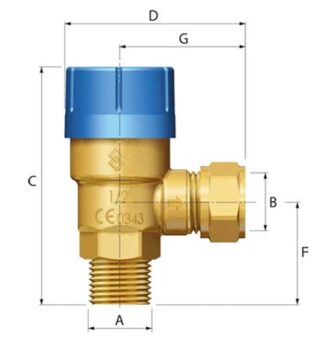Your cart is currently empty!
Safety valve
A safety valve is a small but crucial component in all pressurized water systems, especially in systems with pumps, a pressure tank or a water heater.
It is there for safety reasons – to protect both people and equipment.
A safety valve is an automatic valve that releases water or air if the pressure in the system becomes too high.
It acts as a “safety hatch” – if the pump, pressure switch or control does not shut off in time, the valve opens and releases the excess pressure so that nothing explodes.
1. Protects against excess pressure
- A pump can create much higher pressure than pipes, hoses or tanks can withstand.
- If, for example, the pressure switch sticks or the control hangs → the pump continues to build pressure.
- The safety valve opens automatically (e.g. at 6 bar) and releases water.
- Without it, the pressure tank, pipes or water heater can rupture or explode.
2. Protects against thermal expansion
- In hot water systems (e.g. water heaters), the pressure increases when the water is heated.
- The safety valve compensates for this increase in volume by releasing a little water.
- This prevents the water heater or pipes from being damaged by the thermal overpressure.
3. Protects components in the pump and pipe system
- Pressure switches, hose connections and filters are often sensitive to high pressure.
- A safety valve prevents these components from bursting or starting to leak.
- The location depends on the type of system:
System Location of safety valve
Hydrofor / hydropress system On the pressure side, after the pump – often at the pressure tank.
Automatic pump / pressure booster pump On the outlet, near the pressure side of the pump.
Hot water heater On the cold water inlet to the water heater (always mandatory).
Drinking water system Sometimes combined with a non-return valve and pressure gauge in a safety package.
Pressure levels (typical settings)
System type Opening pressure of safety valve
Water pump system / hydrophore 6 bar (standard)
Pressure increase / house pump 6 – 8 bar
Water heater 9 bar (standard)
Irrigation pumps (low pressure) 3 – 4 bar
The pressure switch should always be set below the opening pressure of the safety valve.
Example: start 2 bar, stop 3.5 bar, safety valve 6 bar.
Maintenance and inspection
- Check once a year by lifting the test lever so that a little water is released.
- If it drips constantly → the spring may be dirty or worn, replace it.
- Make sure the drain hose is free so that water can drain without damaging the interior.




